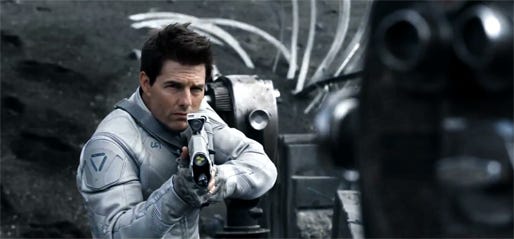Oblivion

Director Joseph Kosinski’s curious, compelling combination of analog patience and digital prowess saves “Oblivion” from its own worst decisions.
Yes, it pathologically piles up twists from a dozen earlier sci-fi movies. It presents action that’s competent and crisp but rarely pulse-pounding. As to the movie’s own heartbeat, it races neither as poetically nor rapidly as the script thinks it does.
“Oblivion” is never boring, but it’s also never better than in its first 45 minutes. It’s then that Kosinski meticulously builds the aesthetics and appearance of our land as the film envisions it in 2077 — decimated by the destruction of Earth’s moon (at the hands of invading aliens) and our scorched-earth nuclear retaliation against them.
That’s because here, finally, is a director not named Christopher Nolan who's resolutely committed to the thrills of a big movie — not “big” in the sense of budget or blockbuster, but in creating a believable enormity in the world onscreen. Here, Kosinski envelops us in macro and micro details for the freshest post-apocalyptic setting in years — seamlessly merging real Icelandic locations and visual effects.
If ever there were a movie for which a studio would have pushed 3D, it’s “Oblivion.” Be thankful Kosinski had the common sense to push back; like “The Dark Knight Rises” before it, “Oblivion” is a beautiful rejoinder to Hollywood’s insistence that “engrossment” must equal “3D.” See it in IMAX, too, for the added immersion is worth the upcharge, as is the rock-concert volume cranked up on an alternately elegiac and energetic score by “Midnight City” hitmakers M83.)
“Oblivion” wisely offers a spectacle big enough to shadow audience suspicions, which qualify for overtime pay after just five minutes of information. At least Kosinski (and co-writers Karl Gajdusek and Michael Arndt) eventually mete out its mysteries with more patience.
Consider “Oblivion’s” first 45 minutes the downbeat denouement to “Independence Day” if its aliens were running Mac systems and Jeff Goldblum’s virus were useless.
Most of who’s left from the human race has retreated to a colony on Titan, a moon of Saturn. But Jack (Tom Cruise) and Vicca (Andrea Riseborough) are mankind’s custodial crew on Earth. Their task is to guard the gargantuan hydro-rigs — sucking up water to power the colony — from “scavs,” the ragtag remnants of repelled aliens, still raising a ruckus.
Jack and Vicca share much more than a mission from their hermetically sealed high-rise in the clouds. He descends for daily patrols in a wasp-shaped jet that resembles an interstellar IKEA vehicle. She runs point from above while remotely reporting to Sally (Melissa Leo) at mission control.
Their tour of duty is almost over, though, and their own passage to Titan just days away. But Jack is haunted by dreams of a woman (Olga Kurylenko) in 2017 New York. And after she falls from the sky in a downed craft, Jack’s journey to find her places the planet’s fate in his hands.
Saying more, or even hinting at the films to which “Oblivion” bears the strongest resemblance, would ruin what are either surprises or eventualities (depending on your science-fiction education).
Of its endgame, it can be said spoiler-free that it only barely probes the human-nature idea of curiosity versus compliance. And for a movie topping two hours, five minutes could have been spared on Jack dealing with ramifications, and emotional reconciliation, of something we learn about his past.
Even in action mode, Cruise is capable of more than stiff-armed running and high-pitched, anguished shout. Here, he’s best at painting Jack as an earthbound misfit who’s carved out his own little shack on the last green bit of land that’s left. (It’s here, too, that the woozy guitar solo of “Ramble On” becomes the soundtrack to an unsettling vision.)
But gone is the wackadoo spontaneity Cruise has brought to many of his roles from the last 10 years, replaced by robotic rigidity for the standard-issue standoff that ends the film. (While his and Kurylenko’s chemistry feels similarly inert, Riseborough hits the right notes of frailty in her emotions and fealty to her mission.)
Then there’s Morgan Freeman, showing up halfway through to collect an exposition-reciting paycheck. Although critical to “Oblivion’s” mystery, his role should have been filled by someone in whose word we might not inherently place so much trust. It’s through him that, just when “Oblivion” could ratchet up the paranoia even further, the movie settles for a mad rush of action sequences.
The saving grace of the second hour are the large, circular attack drones against which Jack regularly squares off. Although they’re obviously computer-generated effects, the drones have a weight, presence and pissed-off disposition that make them formidable foes. They move with a clear sense of sentient disdain, and their design subtly resembles a frowning face.
To the well versed, “Oblivion” certainly lacks the philosophical ferocity of its forbears. But consider the teens that might watch it, their minds as yet un-blown by sci-fi classics of old. After all, there are certainly worse things “Oblivion” could be than a primer, and one that embraces sundry influences with affection, not cynicism.
As in Kosinski’s feature-length debut, “Tron: Legacy,” form ultimately triumphs over function, however entertaining. But at least he’s tipping the scales in the right direction.


